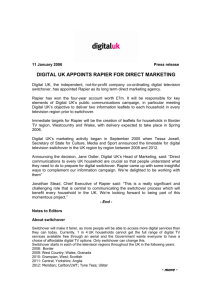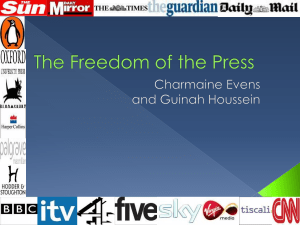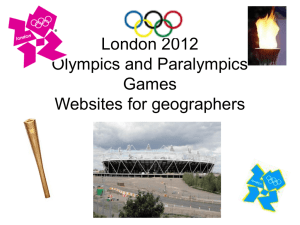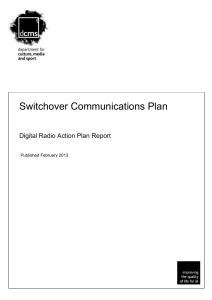Government emergency communications policy
advertisement
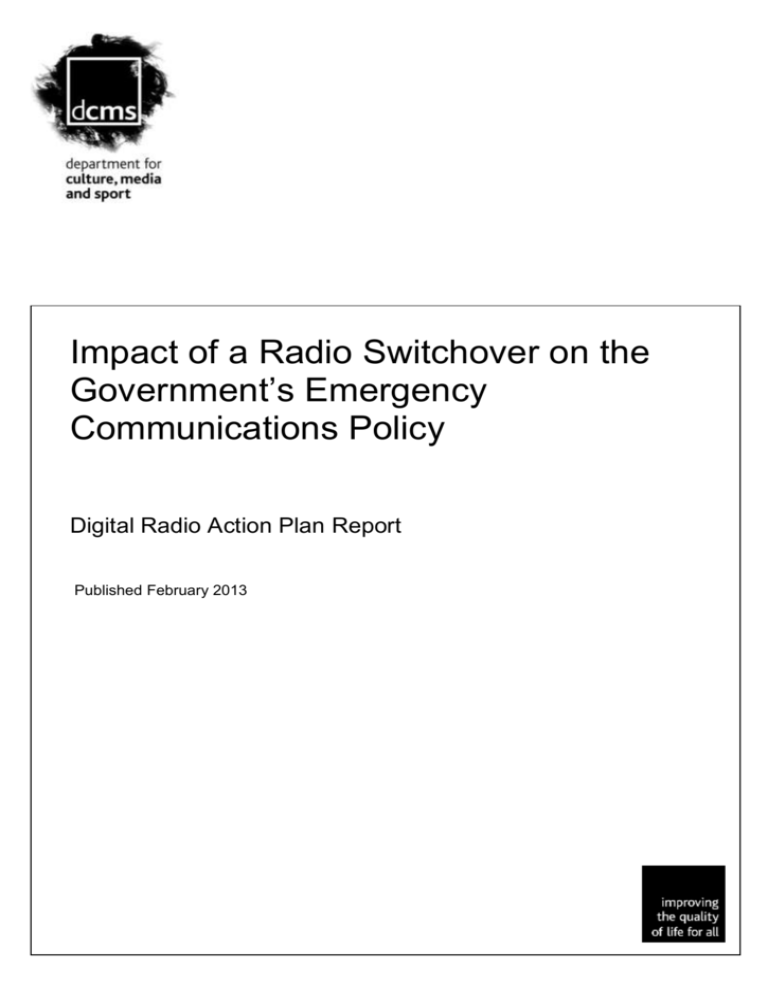
Impact of a Radio Switchover on the Government’s Emergency Communications Policy Digital Radio Action Plan Report Published February 2013 Department for Culture, Media and Sport Our aim is to improve the quality of life for all through cultural and sporting activities, support the pursuit of excellence, and champion the tourism, creative and leisure industries. 2 Department for Culture, Media and Sport 3 Contents Section 1: Foreword................................................................................................................... 4 1.1 Introduction ................................................................................................ 4 1.2 Scope .......................................................... Error! Bookmark not defined. Section 2: Steering Board Decision ........................................................................................... 5 Section 3: Impact of a Radio Switchover on the Government's Emergency Communications Policy Report ............................................................................................................. 6 Department for Culture, Media and Sport Section 1: Foreword 1.1 Introduction 1.1.1. The Digital Radio Action Plan (DRAP) sets out the process for allowing Government to make a well-informed decision on whether to proceed with a Radio Switchover, and if so how, it should be implemented. 1.1.2. The DRAP is delivered through four central working groups, covering technology, market preparation, coverage planning and government policy. A key task of the Government Policy Group, which is led by the Department for Culture, Media and Sport, is to consider the possible impact of a Radio Switchover on the Government’s current civil contingencies policy. 1 1.2 Scope 1.2.1. The radio switchover policy set out by Government proposes that the majority of radio services, including all national and large local services, will cease to be available on analogue broadcast networks. Some small local services, including community radio stations, will remain on FM; AM will no longer be used for radio services2. 1.2.2. Due to the important role which radio has had historically, alongside the importance citizens place on radio in communicating information during a national or local emergency this report considers the impact any transition to digital might have on the existing civil contingency plans and what, if any action, is necessary to mitigate any negative impact. Action 1.5 –Emergency Communications - Identify the impact of a Digital Radio Switchover on the Government’s current civil contingencies policy and where appropriate agree changes in policy. 1 2 While decisions on the future of Long Wave services are not a factor of the radio switchover policy, we note that BBC’s decision in ‘Delivering Quality First’ to cease its services on Long Wave once the existing infrastructure reached the end of its life span. 4 Department for Culture, Media and Sport Section 2: Steering Board Decision The Steering Board considered the ‘Impact of a Radio Switchover on the Government’s Emergency Communications Policy’ report in January 2013. The Board noted radio’s on-going role as one method of communicating to the public in emergency planning and response. It noted that Radio Switchover proposals are based on replicating existing FM coverage and achieving a majority of listening to digital. In this context the Board agreed with the conclusion that the implementation of a switchover policy would not, either during its implementation or after completion, have any significant affect radio’s role in any emergency communications; although the Government will continue to keep this under review. 5 Department for Culture, Media and Sport Section 3: Impact of a Radio Switchover on the Government’s Emergency Communications Policy Report 3.1 Background 3.1.1. Maintaining arrangements to warn, inform and advise the public in the event of an emergency is fundamental to the Cabinet Office’s civil contingencies planning, and is a requirement of the Civil Contingencies Act 2004. 3.1.2. Radio has long been a component of the United Kingdom’s emergency planning policy. As a broadcast platform, radio is well suited to such a task as it is a portable and live medium, radio receivers are often simple to use and consume little energy (often capable of operating with batteries rather than mains power for long periods of time). For these and other reasons, radio has historically been considered an effective and resilient means of communication when other forms of media may be damaged or inoperative. 3.1.3. This is particularly true of AM (Amplitude Modulation) broadcast technologies, specifically Long Wave, which have a reputation as a robust one-to-many broadcast technology. AM services are delivered via low frequencies and as such are more resilient to interference, including electromagnetic interference, than technologies which use higher frequencies, such as FM and DAB. In addition, the coverage of AM services are near universal across the UK, delivered by a small number of transmitters which could more easily be restored in the event of a national disaster. 3.1.4. However, while AM services are universally available, the number of households which both have access to and choose to access such services is on the decline. Listening on AM as a radio platform is generally on the decline, its share of total radio listening fell year-on-year by a third from 2000 to 2005 and has now been surpassed by listening via digital platforms. 3.1.5. In addition, there are already over 16 million digital radio devices (and the number is set to grow further) in the market, with over 40% of all 6 Department for Culture, Media and Sport households having a digital radio. These radios do not have the functionality to receive AM services and while it is likely that the majority of households still have access to an analogue radio with AM it is clear that in many cases these are no longer the primary and most accessible devices in many households. 3.1.6. The declining value of the AM platform is best displayed in the case of the National Attack Warning System (NAWS). The use of the BBC Radio 4 LW frequency to broadcast emergency information nationally in the case of a nuclear attack or similar disaster was formalised through the NAWS arrangements between the BBC and the Cabinet Office. However, as a result of the limitations of this system in the present day, from the falling numbers of LW receivers in homes, to the delay incurred from having to restore transmitters following an attack, the Cabinet Office has since cancelled their NAWS arrangements with the BBC. 3.2 Emergency Communications Policy – Infrastructure 3.2.1. The UK has a number of national and local entities which are responsible for planning and implementing the civil contingencies procedures, some of which are detailed below. 3.2.2. At a local level, the Civil Contingencies Act identifies Category 1 responders who are responsible for assessing risks and preparing emergency plans. The plans identify organisations which have responsibility for maintaining arrangements to provide warning to the public in regard to a particular emergency 3.2.3. On a regional level, Regional Media Emergency Forums (RMEFs) are in place in some English regions, which bring together local authority representatives, emergency planners, emergency services, regional/local media and other interested bodies to work together to help ensure that all parties can cooperate effectively in providing information to the public in the event of an emergency. 3.2.4. A separate Media Emergency Forum (MEF) allows for strategic communications issues to be discussed at a national level among senior media editors, government representatives and representatives of local responders. 3.3 Emergency Communications Policy – Delivery Methods 3.3.1 The Government has identified and implemented a number of communication mechanisms to deliver urgent information to members of the public, these include: Media announcements; Electronic/variable message boards, e.g. at the roadside or on motorways; 7 Department for Culture, Media and Sport National and local radio broadcasts; PA announcements in public buildings, shopping centres, sports venues, transport systems, etc.; From car or helicopter, by loudhailer or other amplified means Automated telephone/fax/e-mail/text messages to subscribers; and Site sirens. 3.3.2. The BBC as the only Public Service Broadcaster who has a significant presence on terrestrial TV and Radio has always had a key role in the delivery of communicating in the event of an emergency; a function which is set out in the BBC Charter. The BBC’s operates the Connecting in a Crisis3 initiative, which helps ensure that the public has the information it needs and demands during a civil emergency. Information on the BBC’s Connecting in a Crisis systems can be found at www.bbc.co.uk/guidelines/dq/pdf/cont/BCP_Policy08.pdf . 3.4 Impact of a Radio Switchover 3.4.1. Despite an increasing number of means of communicating in the event of a local or national emergency, radio is still considered an important element. In a national survey4 of adults, carried out by IPSOS/MORI for the Cabinet Office in 2012, respondents indicated the five most preferred methods of receiving information about a major emergency situation in their local area were: announcements on television (62%), announcements on radio (34%), text/SMS message (19%), In person e.g. knocking on door (17%) and email (14%). 3.4.2 As noted above it is proposed that following a Radio Switchover, the majority of radio services, including all national and large local services, will cease to be available on analogue broadcast networks, with only small scale services on FM. 3.4.3 The criteria which Government has stated would need to be satisfied before any Radio Switchover is that: 50% of listening is to digital platforms; and national coverage is comparable to FM and local coverage reaches 90% of the population and all major roads. The BBC’s Connecting in a Crisis scheme helps ensure that the public has the information it needs and demands during a civil emergency. It sets out to encourage emergency planners to work more closely with broadcasters in the preparation of strategies for communicating essential information. 3 4 Emergency Alert Pilot Evaluation and Preparedness Survey IPSOS/MORI February 2012 8 Department for Culture, Media and Sport This is just the threshold for setting a date for switchover and it will be necessary for coverage of both local and national to match current FM levels and near universal conversion of households (who consume radio) before any switchover takes place. Therefore, the implementation of a switchover policy would not, either during its implementation or after completion, affect radio’s role in any emergency communications. 3.4.4 We also note that while at this time transmission provider’s business continuity procedures5 are specifically intended to address major incidents relating to the analogue terrestrial broadcast networks. These procedures will transfer to digital at the point in which analogue networks are no longer operational. This means that the digital radio networks are restored promptly and efficiently following any loss of service, supported by the necessary manpower and equipment resources required to address most failure scenarios. 3.4.5 Finally, there have been concerned raised about the power consumption of digital radios compared to analogue equivalents means they are less effective in the event of emergencies; on the basis they will operate for a short period on battery power. The energy consumption of digital radios is being considered as part of Action 2.6 of the DRAP. However, we note that energy consumption of digital radios is already similar to analogue radios and improvements in technology are resulting in greater improvements in this area. The Government’s research into the energy consumption of digital radio can be found at: http://www.culture.gov.uk/publications/8145.aspx 3.5 Conclusion 3.5.1. It is clear that radio, both as in analogue and digital form, continues to have an on-going role in emergency planning protocols, although it is now part of a wider range of communication methods. 3.5.2. While a radio switchover will result in the closure of AM services, which had historically been important to the Government’s protocols in this area, the diminishing value of this platform means it is increasingly less relevant as a universal communication platform. As a result in considering the impact of a possible switchover it is necessary to compare digital radio against FM not AM services. In this context the Radio Switchover proposals will replicate existing FM coverage and ensure a transition which protects consumers, therefore assuring an efficient transition and the widespread availability of radio services capable of having an active future role in communicating during local and national events. 5 Transmission continuity vary depending on individual contractual arrangements. 9

